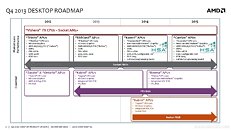Tuesday, December 3rd 2013

"Vishera" End Of The Line for AMD FX CPUs: Roadmap
We'd feared something like this would happen for some time now, but leaked AMD product roadmaps confirmed it that AMD FX "Vishera" is the last line of CPUs from AMD. The company will only focus on APUs from here onward, and at the very most, one could expect CPU core counts to go up from their current quad-core stale-meat since A-series "Llano," which will continue into the 2014 A-Series "Kaveri," too.
The alleged AMD roadmap slide leaked to the web by ProHardver.hu points out that socket AM3+ "Vishera" will exist on AMD's product stack for as far as AMD's eye can see - looking deep into even 2015. Unless AMD is planning on hanging its towel with AM3+, it wouldn't mark its roadmap slide out in this way. 2015 will see the introduction of "Carrizo," an APU that succeeds "Kaveri," which will be based on future-generation "Excavator" CPU micro-architecture, and a future-generation GPU architecture, along with full HSA programming model implementation. "Kabini" will have its spell running into mid-2014, at which point "Beema" will succeed it.Unless AMD is planning on 6-core, and 8-core APUs with "Carrizo," (we know that "Kaveri" is neither,) the roadmap reveals that AMD has given up on making processors that are pricier than $150. The company could focus its client products division onto APUs and GPUs, while multi-core processors could be kept alive by the enterprise products division under the Opteron banner, although we've not seen roadmaps to back that theory.
Sources:
ProHardver.hu, SweClockers
The alleged AMD roadmap slide leaked to the web by ProHardver.hu points out that socket AM3+ "Vishera" will exist on AMD's product stack for as far as AMD's eye can see - looking deep into even 2015. Unless AMD is planning on hanging its towel with AM3+, it wouldn't mark its roadmap slide out in this way. 2015 will see the introduction of "Carrizo," an APU that succeeds "Kaveri," which will be based on future-generation "Excavator" CPU micro-architecture, and a future-generation GPU architecture, along with full HSA programming model implementation. "Kabini" will have its spell running into mid-2014, at which point "Beema" will succeed it.Unless AMD is planning on 6-core, and 8-core APUs with "Carrizo," (we know that "Kaveri" is neither,) the roadmap reveals that AMD has given up on making processors that are pricier than $150. The company could focus its client products division onto APUs and GPUs, while multi-core processors could be kept alive by the enterprise products division under the Opteron banner, although we've not seen roadmaps to back that theory.

133 Comments on "Vishera" End Of The Line for AMD FX CPUs: Roadmap
Clock-for-clock Core2 was much faster than Athlon64 and Phenom.
Just go back to the old reviews. 2.4GHz E6600 completely dominated the 3GHz Athlon 64 X2 6000+
You are cherry picking too because when AMD moved to the "Kuma" Athlon 64 revision i.e. Athlon X2 7750 BE the performance was very competitive with the Core 2 Duo Conroe.
When AMD moved to Callisto i.e. Phenom II X2 560, it was neck and neck competitive with the E8400. The Athlon II X2 could also compete and sometimes outcompete the E8400. (also the Athlon II X3 was much cheaper than a E8400 and handily dominated the entire Core 2 Duo series).
But we have selective memories of those events :)
So please, people, a little less with the uneducated biased and/or hateful comments that have nothing to do with reality, and think.
AMD would show a lack of strength and confidence in their own products if they would release FX processors on the side, again people, think god damn it.
Too bad for the time being, APUs still sound good only on paper... but we shall see.
Rats, was hoping AMD might spin one more interation for AM3 socket. Nothing all that earth-shaddering, just wanted like a 6-core 95W part the had had a little more oomph or a "Black". My boy's are on 870 based machines and hoping to stretch one more upgrade, looks like FX-6300 are all I'll have to look at.
AMD... start offering tray parts for $20 less! please...
The Wolfdale Core 2 Duos were around when the Phenom II X2 560 and Athlon II X2/X3 was around competing with it - either way you look at it jihadjoe's statement wasn't 100% accurate.
For that, they will need to keep the socket constant and start or refine the architecture from scratch. As for Vishera, the architecture is good enough especially the 63xx and the 83xx.
I've used APU for HTPCs but to be honest even Intel HD is good enough for HTPC unless you are going for 4K or something in which case you would need a dedicated gpu anyway.
Come back again to FX, I would say they are good for the price apart from the 4xxx series. I don't find any reason to get a Core i3 instead of a FX 6xxx.
I am not a fanboy. I am just at the reality. Here where I live, at this moment, a FX 8350 and Core i5 3570 costs the same. Both are good at their fields and performs more or less the same overall.
And the reason I said that FX needs better caches is because if you bench using AIDA cache and memory benchmark, FX L2 and L3 caches perform really bad. You can check out yourself.
Both roadmaps are the same, the only difference is that the top one includes 2012 and 2015. Both say that Piledriver (Vishera) will be the only architecture available for the AM3+ platform for the comming years.
Wierd D D D I dont think a future without Amd high end cpu's is a cheap one or one i would like
This end of the cpu twaddle has been spouted add nauseum for the last few years and all regardless of the FACT that binning will retain pure cpu types even when the gpu is integrated because its better then bining them(actual dustbin) (the ones the gpu is broke on) and were not even in that yard yet since Amd and intel still need server parts and the resultant refuse becomes consumer parts.
Fx's will continue to evolve in a positive way as mine has with better software ,Api's ,and Os's
Amd has historically always suffered under Intel's shadow. The only times they've been able to out maneuver Intel is when they've gone for the "hail mary pass" so to speak. Think about it, what was the last truly innovative CPU technology that Intel produced on it's own? If you don't count instruction set extensions which can be of dubious use I'd say, hyper threading. The one before that, on die L2. That's it. The L2 would of been pretty obvious to any one. There could be some debate about Hyper threading, but everyone knew eventually multi-core CPUs were coming. Hyper Threading was just a step in between single core and multi-core. On the other hand AMD has produced a lot of innovations that are in common use today and a lot of people (even me) saw dubious worth in them.
When Intel's Netburst was first on the drawing table it was all about clock speed. Amd and Intel had been trading blows and neither really had the upper hand, even with AMD being the first to reach 1GHz. So while Intel pursued their failed Netburst architect (it never scaled in the manner Intel thought it would) and ever climbing FSB speeds, AMD introduced a much more efficient core architect making over all clock speed less important. They then added the following, first an on die memory controller making FSB less of an issue. Secondly a 64bit extension to the X86 instruction set. I'll admit I was even one to say "so what, other then memory limits, why do we need 64bit" Okay and I was wrong, how many people still run a 32bit OS? Fourth they introduced the first true dual core. And lastly they introduced on die GPUs. All innovations that AMD pioneered and Intel later adopted.
AMD became king of the mountain around the time of the 64bit extensions. In fact that's why they first introduced the FX line of processors. Insanely priced, but the best you could get. As it later came out, and was well documented, the only way Intel could even compete was by forcing OEMs to only carry Intel products. Intel all most lost the race except for a strange turn of events. Enthusiasts had started to use the Pentium M processor (part of the Centrino brand) for desktop use. While Intel may not be as innovative as AMD, that doesn't mean their not smart, and they saw the potential the Pentium M had. I'd say that Intel's biggest strengths is it's all most inexhaustible resources and it's ability to turn on a dime and refocus on more promising avenues. Which is exactly what they did. Intel has taken the Pentium M and over time added all of AMD's innovations to the point where they totally dominate the CPU market. In truth AMD's only recourse is to offer deep discounts on their flagship products. It's sad, but it's also true.
So what can AMD do to once more get out of Intel's shadow? It's pretty obvious that no matter what AMD does with their current processors they will always be playing second fiddle to Intel's. They'll never be a threat. In fact as been shown with Intel's last generation Intel doesn't even consider AMD a threat anymore. In stead of increasing CPU performance they seem to be concentrating on reducing power consumption and heat. And that makes sense because of the rise of mobile computing and how ARM has risen to become a major player. Intel has it's sights set on taking on ARM, not AMD. But this gives AMD a advantage they haven't had since the Athalon 64 days, room to breath and maneuver.
So what can they do with this breathing room? Well they could keep trying to improve traditional processor performance, but we all know where that will lead. No AMD needs to do what AMD does best. Come out of left field with a new technology that no one thinks is viable, just like they did in the past. So what does AMD have that Intel just can't touch? GPU performance on their APU dies. While Intel has made great leaps in this area, they'll never be able to touch AMD, they simple have to much of a lead. So AMD needs to leverage that advantage in the best way it can. How can they? While it's true that more and more applications are taking advantage of mulit-core CPUs, simply adding even more and more cores is eventually a dead end solution. Instead why not throw that "hail mary pass"? Produce an entirely different approach something like a heterogeneous CPU. en.wikipedia.org/wiki/Heterogeneous_computing
AMD already has many of the parts already in place on the CPU die, and if their Heterogeneous initiative succeeds. hsafoundation.com/ They might just pull it off. All they really need once it's up and running is a "killer app" and AMD will quite likely make an end run around Intel.
With all that in mind AMD can't afford to be split into a APU and CPU company. This is an all or nothing play. A true "hail mary pass". So eventually AMD was going to have to go this route any way. I'm just hoping that it means AMD's heterogeneous system architect isn't that far away. It just might be one of the biggest game changers for desktop computing we've seen yet, and save AMD's bacon in the process.